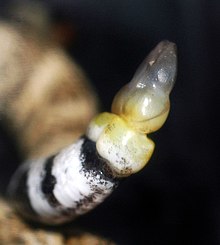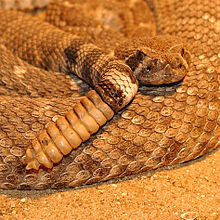Western diamondback rattlesnake
This article needs additional citations for verification. (March 2024) |
| Western diamondback rattlesnake | |
|---|---|

| |
| Scientific classification | |
| Domain: | Eukaryota |
| Kingdom: | Animalia |
| Phylum: | Chordata |
| Class: | Reptilia |
| Order: | Squamata |
| Suborder: | Serpentes |
| Clade: | Caenophidia |
| Clade: | Colubroides |
| Family: | Viperidae |
| Subfamily: | Crotalinae |
| Genus: | Crotalus |
| Species: | C. atrox
|
| Binomial name | |
| Crotalus atrox | |

| |
| Synonyms | |
| |
The western diamondback rattlesnake[3] or Texas diamond-back[4] (Crotalus atrox) is a rattlesnake species and member of the viper family, found in the southwestern United States and Mexico. Like all other rattlesnakes and all other vipers, it is venomous. It is likely responsible for the majority of snakebite fatalities in northern Mexico and the greatest number of snakebites in the U.S.[5] No subspecies are currently recognized.[3]
It lives in elevations from below sea level up to 6,500 feet (2,000 m). This species ranges throughout the Southwestern United States and northern half of Mexico. Currently, western diamondback rattlesnakes are not threatened or endangered.
Common names
Other common names for this species include western diamond-backed rattlesnake,[3] adobe snake, Arizona diamond rattlesnake, coon tail, desert diamond-back, desert diamond rattlesnake, fierce rattlesnake, spitting rattlesnake, buzz tail, Texan rattlesnake, Texas diamond-back, and Texas rattler.
Description

Adults commonly grow to 120 cm (4 ft) in length. Specimens over 150 cm (5 ft) are infrequently encountered, while those over 180 cm (6 ft) are very rare, and the largest reported length considered to be reliable is 213 cm (7 ft).[6] Males become much larger than females, although this difference in size does not occur until after they have reached sexual maturity.[5] Rattlesnakes of this species considered medium-sized weigh up to 1.23 to 2.7 kg (3 to 6 lb), while very large specimens can reportedly weigh up to 6.7 kg (15 lb).[7][8][9] Overall, it is probably the second largest-bodied species of rattlesnake, behind only its close cousin the eastern diamondback rattlesnake, and is also the second largest of North American venomous snakes (the bushmasters, which attain probably similar weights and greater total length, occur up as far as Nicaragua).[10][11][12]
The color pattern generally consists of a khaki ground color, but it may also be pinkish or fallow, brick red, yellowish blonde, or white. This ground color is overlaid dorsally with a series of 23-45 (mean, 36) dorsal body blotches that are brown or a darker umber.

The wide range of this species overlaps, or is close to, that of many others. It may be confused with them, but differences exist. The Mojave rattlesnake (
Distribution
Geographic range
It is found in the
In the United States, it occurs in central and western Arkansas, Oklahoma excluding the northeast, north-central region and the panhandle, Texas excluding the northern panhandle and the east, southern and central New Mexico and Arizona, extreme southern Nevada, southwestern Utah, and in southeastern California on either side of the Chocolate Mountains. Records from extreme southern Kansas (Cowley and Sumner Counties) may be based on a natural occurrence of the species, while multiple records from near Kanopolis Reservoir in Ellsworth County seem to indicate a viable (although isolated) population.[5]
In Mexico, it occurs in Nuevo León, Coahuila, Chihuahua, Sonora, extreme northeastern Baja California, northern Sinaloa, northeastern Durango, Zacatecas, most of San Luis Potosí, northern Veracruz, Hidalgo, and Querétaro. Specimens have been collected in the mountains northwest of Tehuantepec, Oaxaca, on numerous occasions, but have not been reported there since the 1940s.[5]
This species has also been reported on a number of islands in the
Habitat
Its habitats range from flat coastal plains to steep rocky canyons and hillsides; it is associated with many different vegetation types, including desert, sandy creosote areas, mesquite grassland, desert scrub, and pine-oak forests. Frequently roaming during the day, it is common to see the western diamondback when ambient temperatures drop because of the heat retention of blacktop roads. [14]
Behavior

C. atrox is
They are poor climbers. Natural predators include raptors such as hawks and eagles, roadrunners, wild hogs, and other snakes. When threatened, they usually coil and rattle to warn aggressors. They are one of the more defensive rattlesnake species in the US in the way that they stand their ground when confronted by a foe. If rattling does not work, then the snake will strike in defense.[15][citation needed]
Prey
A comprehensive study by Beavers (1976) on the prey of C. atrox in Texas showed, by weight, 94.8% of their prey consisted of small mammals.
Birds, lizards, amphibians, fish, invertebrates,
Hermann (1950) reported C. atrox also feeds on lubber grasshoppers (
They hunt (or ambush prey) at night or in the early morning.
These snakes can go for up to two years without food in the wild. A 5+1⁄2-month starvation study showed the snakes reduced energy expenditures by an average of 80% over the length of the study. The snakes also feed from within on energy-rich lipid stores. The most interesting finding was the snakes grew during the study, indicating while the snake's mass was shrinking, it was putting its resources into skeletal muscles and bone.[17]
A key participant in the
They are one of the few species of snakes that engage in scavenging behavior.[21]
Venom

Like most other American pit vipers, the venom contains proteolytic enzymes. Proteolytic venoms are concentrated secretions that destroy structural tissues and proteins via catabolism, which help in disabling prey. The venom of C. atrox is primarily hemotoxic, affecting mainly the blood vessels, blood cells and the heart. The venom contains hemorrhagic components called zinc metalloproteinases.[22][23] The venom also contains cytotoxins and myotoxins which destroy cells and muscles, adding to the damage to the cardiovascular system.[24] In addition to hemorrhage, venom metalloproteinases induce myonecrosis (skeletal muscle damage), which seems to be secondary to the ischemia that ensues in muscle tissue as a consequence of bleeding and reduced perfusion. Microvascular disruption by metalloproteinases also impairs skeletal muscle regeneration, being thereby responsible for fibrosis and permanent tissue loss.[25] General local effects include pain, heavy internal bleeding, severe swelling, severe muscle damage, bruising, blistering, and necrosis; systemic effects are variable and not specific, but may include headache, nausea, vomiting, abdominal pain, diarrhea, dizziness, and convulsions. Bleeding caused by hemorrhagins is a major clinical effect that can be fatal.[26]
This species has LD50 values of 2.72 mg/kg intravenous, 20 mg/kg intramuscular and 18.5 mg/kg subcutaneous, which is far less toxic than many other rattlesnakes.[27][28] However, because of its large venom glands and specialized fangs, the western diamondback rattlesnake can deliver a large amount of venom in a single bite. The average venom yield per bite is usually between 250 and 350 mg, with a maximum of 700–800 mg.[5][29] Severe envenomation is rare but possible, and can be lethal. Mortality rate of untreated bites is between 10 and 20%.[26]
Reproduction
Rattlesnakes, including C. atrox, are
Conservation status
This species is classified as Least Concern on the IUCN Red List (v3.1, 2001).[1] Species are listed as such due to their wide distribution or presumed large population, or because they are unlikely to be declining fast enough to qualify for listing in a more threatened category. The population trend was stable when assessed in 2007.[30]
They are also heavily collected from the wild, frequently being drawn out of their hiding places with gasoline and used in
This Western diamondback rattlesnake may be the most common rattlesnake species found in homes and in direct conflict with human development in the
Gallery
-
C. atrox, albino specimen
-
C. atrox, melanistic specimen
-
C. atrox
-
C. atrox
References
- ^ . Retrieved 19 November 2021.
- ^ ISBN 1-893777-01-4.[page needed]
- ^ a b c "Crotalus atrox". Integrated Taxonomic Information System. Retrieved 28 November 2006.
- ISBN 0-8014-0463-0.[page needed]
- ^ ISBN 0-8014-4141-2.
- ^ ISBN 0-520-21056-5.[page needed]
- PMID 2757285.
- ^ Crotalus atrox Western Diamond-backed Rattlesnake. Encyclopedia of Life
- .
- PMID 3513378.
- ^ Taylor, E. N.; Denardo, D. F. (2005). "Sexual size dimorphism and growth plasticity in snakes: an experiment on the Western Diamond‐backed Rattlesnake (Crotalus atrox)". Journal of Experimental Zoology Part A: Ecological Genetics and Physiology. 303 (7): 598–607.
- JSTOR 2423378.
- ^ Ernst, CH; Ernst, EM. 2003. Snakes of the United States and Canada. Washington, D.C.: Smithsonian Institution.
- ^ ISBN 978-0-394-48882-0.
- ^ "Snakes in the Garden- the Good, the Bad and the Ugly". Dave's Garden.
- ^ "Crotalus atrox (Western Diamond-backed Rattlesnake)".
- .
- "Why Does A Starving Diamond-Back Continue To Grow? Optimism!". ScienceDaily (Press release). April 6, 2006.
- ^ Western Diamond-backed Rattlesnake (Crotalus atrox) – Reptiles of Arizona Archived 2015-10-30 at the Wayback Machine. Reptilesofaz.org. Retrieved on 2016-12-26.
- PMID 9267421.
- PMID 29844637.
- .
- .
- PMID 210790.
- PMID 19371136.
- PMID 11086214.
- ^ a b Clinical Toxinology Resource (Crotalus atrox). Toxinology.com. Retrieved on 2016-12-26.
- ^ Sean Thomas LD50 Archived 2012-02-01 at the Wayback Machine. Seanthomas.net. Retrieved on 2016-12-26.
- ^ Fry, Bryan Grieg. LD50 Menu. venomdoc.com
- ISBN 0-398-02808-7.[page needed]
- ^ 2001 Categories & Criteria (version 3.1) at the IUCN Red List. Accessed 13 September 2007.
- ^ L. Pitts, Steven & Hughes, Bryan & Mali, Ivana. (2017). Rattlesnake Nuisance Removals and Urban Expansion in Phoenix, Arizona. Western North American Naturalist. 73. 309-3016. 10.3398/064.077.0304.
- ^ Nowak, E.M., Hare, T, & McNally, J (2002). Management of nuisance vipers: effects of translocation on western diamondback rattlesnakes (Crotalus atrox). Biology of the Vipers, 533-560
Further reading
- Baird, S.F. & C. Girard. 1853. Catalogue of North American Reptiles in the Museum of the Smithsonian Institution. Part I. – Serpents. Smithsonian Institution. Washington, District of Columbia. xvi + 172 pp. (Crotalus atrox, pp. 5–6.)
- Yancey FD II, Meinzer W, Jones C. 1997. Aberrant morphology in western diamondback rattlesnakes (Crotalus atrox). Occasional Papers of the Museum of Texas Tech University, 167: 1–4. PDF at Natural Science Research Laboratory. Accessed 26 August 2007.
- Richards, I. S., & Bourgeois, M. M. (2014). Principles and practice of toxicology in public health (2nd ed.). Burlington, MA: Jones & Bartlett Learning.
External links
- Crotalus atrox at the Reptarium.cz Reptile Database. Accessed 26 August 2007.
- Western Diamondback Rattlesnake Facts & Photos at the University of Washington. Accessed 1 September 2008.
- Crotalus atrox care sheet at VenomCenter.com





